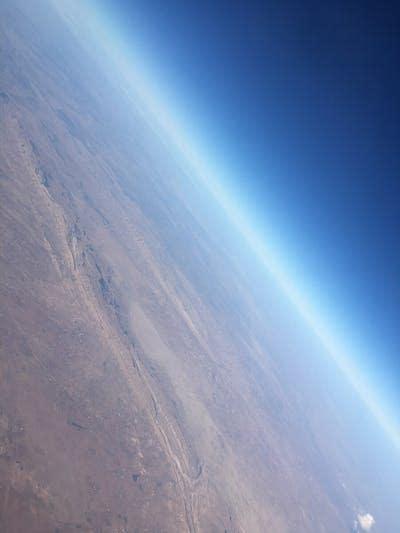

What is space made of - what does gravity actually bend? - Phil, age 12, Birmingham
What comes to mind when you think of space? Imagine a friend bragging about a spacious building, stadium, or museum he recently visited. Do you see the building as huge and expansive? Is it just really big, or does it seem empty?
The word spacious does not necessarily mean empty. It simply indicates that there is enough room to move around the objects in it. In the same way, space is not completely empty. It is vast and constantly expanding, but there is a lot of stuff in it.
As a child, I wondered how far away the clouds were, what was beyond the Earth, and how big space was. This curiosity led me to pursue a master's and doctorate in astronomy. I have been teaching these concepts for twenty years as a physics professor at the University of Texas, Arlington.
Where does space begin?
The Earth is surrounded by layers of different gases. At sea level, the Earth's atmosphere contains about 100 billion molecules per cubic centimeter. As we ascend, the atmosphere becomes thinner and thinner.


At an altitude of about 50 to 62 miles (80 to 100 km), there is not enough air for airplanes to fly. This boundary, which separates Earth's atmosphere from space, is called the Kármán line, named after the Hungarian-American engineer and physicist Theodore von Kármán. Everything above the Kármán line is called space.
The density of space can vary, but on average it is about 1 atom per cubic centimeter. Imagine: a cube the size of a dice of Earth's atmosphere contains billions of air particles. But in space, the same cube contains only one or two particles.
The Interstellar Medium and Radiation
Space, or outer space, is a vast, nearly perfect vacuum that is largely devoid of matter. This vacuum contains very few particles compared to Earth's atmosphere. However, it is not completely empty.
Space is littered with scattered matter, the interstellar medium, which contains hydrogen and helium atoms. These are the most common elements in space, and they exist in both charged and neutral forms. The interstellar medium also contains cosmic dust - tiny particles of various elements, including carbon and silicon, scattered throughout space.
High-energy particles called cosmic rays-primarily protons and atomic nuclei-travel through space at nearly the speed of light. Cosmic rays come from various stars, including our sun, but also from supernovae, material falling into black holes, colliding galaxies, and more.
Space is filled with various forms of radiation, including cosmic microwave background radiation. This is leftover heat from the origins of the universe. High-energy cosmic events such as supernovae and black holes also emit X-rays and gamma rays.
Magnetic fields generated by stars, planets and many other celestial bodies also permeate space. These fields influence the motion of charged particles by attracting or repelling them like magnets.
Dark matter and dark energy
Scientists predict that a previously unseen form of matter that does not emit light or energy, called dark matter, makes up a significant fraction of the universe's mass. Researchers suspect it exists because they can see its gravity on other visible matter.
Likewise, scientists predict that a mysterious form of energy called dark energy is driving the accelerating expansion of the universe. Unlike dark matter, dark energy is not related to matter or gravity, but is a property of space itself.
Imagine the universe as a balloon. Dark matter is like the material of the balloon, and affects its shape, while dark energy is like the air that is pumped into it. It doesn't change the material of the balloon, but it does affect how quickly the balloon expands.
Is space warped? Can gravity bend space?
Space can also warp. Imagine that space is a large, stretchy trampoline. If you place a heavy ball, like a bowling ball, in the middle of the trampoline, it will make a large dip downward. This dip is similar to how space warps around something large, like a planet or a star. The larger the ball, the stronger the gravity and the deeper the dip.
If you roll a smaller marble on the trampoline with the bowling ball in the middle, marbles can go around the dip that the gravity of the bowling ball creates. The marble follows the curve of the dip, just as planets follow the curve of space around the sun.
Imagine shining a flashlight across the trampoline. As the light approaches the dip made by the bowling ball, it may bend slightly as it travels. This is similar to how light bends when it passes by a very large object in space, such as a galaxy.
Think of a black hole, which has an enormous gravitational pull, as an even bigger, deeper dip in the trampoline. If you were to roll a marble too close to this super-deep dip, it would fall in and disappear, just as things can be pulled into a black hole in space and not be able to escape.
So space can warp or curve around large objects that have a lot of gravity, just as a trampoline warps if you place a heavy ball on it.
Space is more than just empty space. It contains a mix of particles, radiation, magnetic fields, and mysterious forms of matter and energy. Imagine space as a 3D playground, where objects like stars, planets, nebulae, and galaxies exist and together form our fascinating and complex universe.
Hello, curious kids! Do you have a question you'd like an expert to answer? Ask an adult to send your question to [email protected]. Tell us your name, age, and the city you live in. And since curiosity knows no age limit - adults, let us know what you are wondering too. We can't answer all questions, but we'll try our best. This article is republished from The Conversation, a nonprofit, independent news organization that brings you facts and reliable analysis to help you understand our complex world. It was written by: Nilakshi Veerabathina, University of Texas at Arlington Read more: Nilakshi Veerabathina is not an employee of, an advisor to, an owner of shares in, or a recipient of funding from any company or organization that would benefit from this article, and has disclosed no relevant affiliations beyond his academic appointment.